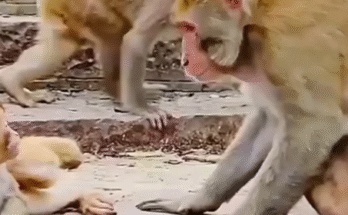
There’s a special kind of comfort in knowing someone is watching over you—someone attentive, caring, and vigilant. For a child taking her first steps, for a small one exploring the world, or even for a young animal learning to navigate unfamiliar terrain, that watchful presence makes all the difference. She has a good nanny, one who keeps an eye on her so she doesn’t fall, and in that careful guidance lies love, trust, and the kind of quiet protection that shapes confidence and safety.
TEarly Steps
The little girl was no more than two years old, her legs still unsteady, her steps uncertain. Every movement was a mix of curiosity and caution, her tiny feet exploring a world much bigger than herself. She wanted to run, jump, and discover, but the simple act of walking was still a challenge.
Her nanny, ever watchful, stayed close behind. Every hand extended, every slight bend in posture, every tilt of the head was a readiness to intervene if needed. The nanny didn’t rush her or pull her forward; instead, she allowed her to move at her own pace, ready to catch her if balance faltered.
This was not just physical protection—it was emotional support. The child knew, instinctively, that she was safe, that exploration was possible without fear. Confidence was growing with every step.
The Nanny’s Role
A nanny’s job is far more than supervision. It is vigilance, understanding, and intuition combined. The nanny in this story had spent countless hours learning the rhythms of the little girl—how she moved, where she tended to stumble, what excited her, and what frightened her.
She adjusted her distance constantly, never too close to stifle independence, never too far to risk danger. Every small movement was a delicate dance: guiding without controlling, protecting without restricting, and teaching without imposing.
Moments of Near-Fall
It didn’t take long for the first incident to occur. The little girl, distracted by a butterfly fluttering nearby, took a step too far. Her foot slipped on the edge of a rug. In that instant, the nanny’s hand was there, steadying her before she could hit the floor.
The girl looked up, startled, but not scared. The presence of the nanny reassured her: falling wasn’t the end of the world, because someone was there to help. This repeated countless times, each near-fall a lesson in balance and each rescue a demonstration of attentive care.
Teaching Through Guidance

Part of the nanny’s role was to teach balance without forcing it. She would gently encourage the child to take steps independently, to reach for objects slightly out of reach, or to step over small obstacles.
Every time the girl stumbled but regained her footing, it was a victory. The nanny celebrated each success, clapped, and offered praise. Positive reinforcement made the child eager to try again, learning that even if she faltered, recovery was possible and encouragement awaited.
Learning to Trust
Trust is built slowly, and nowhere is it more evident than in the relationship between a careful nanny and a child learning to navigate the world. The girl learned to trust her own strength, knowing that the nanny would support her if needed. This trust allowed for exploration and growth, transforming small steps into confident strides.
In essence, the nanny was a bridge between fear and courage, safety and adventure. Her vigilance enabled freedom. Every step taken, every stumble avoided, and every hand extended created a foundation of security and independence.
Exploration and Curiosity
With a good nanny watching, the girl’s world expanded. She began exploring corners of the house, reaching for toys on higher shelves, and even attempting small stairs. Each new experience was accompanied by cautious observation from the nanny, ready to intervene but letting the girl attempt it herself.
The child learned more than physical balance; she learned decision-making, spatial awareness, and the subtle judgment of risk. With the nanny nearby, every exploration was both a challenge and an opportunity for growth.
Small Victories
Each successful step, each independent movement, was a milestone. The nanny’s careful attention allowed the child to experience the thrill of achievement without unnecessary danger.
When the girl finally climbed a low step without support or reached a toy without tipping over, the nanny clapped her hands, smiled, and praised her. These small victories, though simple, were monumental in building self-esteem. They were the fruits of vigilance, patience, and loving care.
The Balance of Independence and Protection
A great nanny understands the balance between letting a child grow and keeping them safe. Too much intervention stifles confidence; too little risks injury. The nanny in this story mastered this balance.
She allowed the girl to explore, to wobble, to test her limits—but always with a steady hand nearby. Her presence was invisible yet essential, like a safety net that allowed risk without catastrophe. In this way, the child learned not only physical skills but also emotional resilience and trust.
Teaching Life Lessons

Beyond preventing falls, the nanny was teaching life lessons. She showed that mistakes and near-misses are part of learning, that seeking help is not weakness, and that support can coexist with independence.
Every time the child nearly fell and was steadied, she learned that safety comes from both awareness and collaboration. She learned to assess her environment, to plan her movements, and to understand the importance of guidance. These lessons would extend far beyond her first steps into other areas of life—school, friendships, and personal challenges.
The Emotional Connection
A nanny’s care creates a unique emotional bond. The girl grew to understand that her caretaker was not just a supervisor but a companion, mentor, and source of comfort. This relationship fostered emotional security, allowing the child to explore confidently while knowing that support was always nearby.
The bond was evident in small gestures: the child looking back for reassurance, smiling when caught, or reaching up for the nanny’s hand when uncertain. These moments strengthened attachment, trust, and confidence.
The Joy of Watching Growth
For the nanny, the joy was in witnessing progress. Each wobble transformed into a confident stride, each near-fall became a step toward independence. The satisfaction of seeing a child learn, explore, and succeed is profound. It’s a combination of love, patience, and pride that cannot be measured in words.
Every day brought new challenges, new discoveries, and new opportunities to provide support. The nanny’s attentive care was not just about preventing accidents—it was about enabling growth and fostering resilience.
Conclusion
“She has a good nanny; she keeps an eye on her so she doesn’t fall.” These words capture more than supervision—they capture vigilance, love, and the delicate balance of guidance. The nanny’s presence allowed the child to explore, learn, and grow without fear.
In this simple act of watchfulness lies profound lessons: the importance of trust, the value of support, and the power of patient guidance. The child learned to move, to balance, and to venture further with confidence, all because someone cared enough to be present, attentive, and ready.
In every small step, stumble, and triumph, the nanny’s influence shaped not just physical skill but emotional resilience, trust, and the courage to explore the world. She was more than a caretaker—she was a guide, a protector, and a quiet source of strength. And in her watchful eyes, the child learned the greatest lesson of all: that with care, attention, and love, we can face the world safely and confidently.



